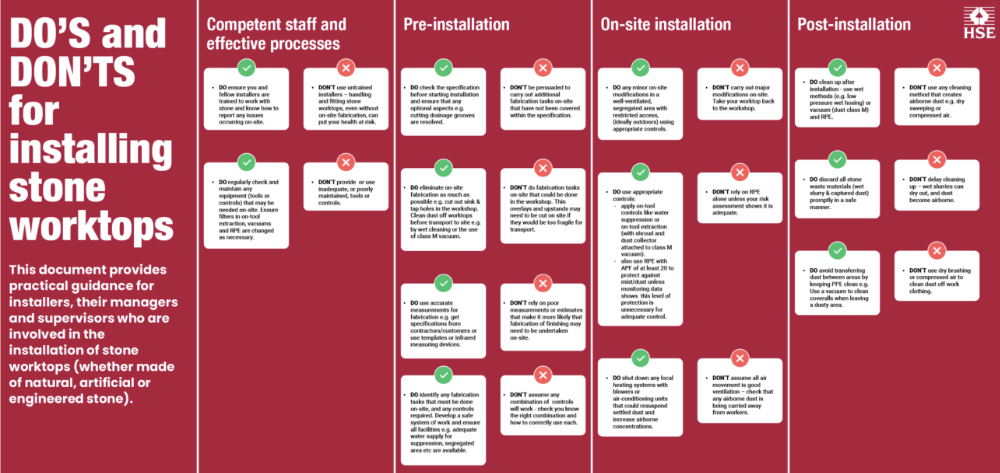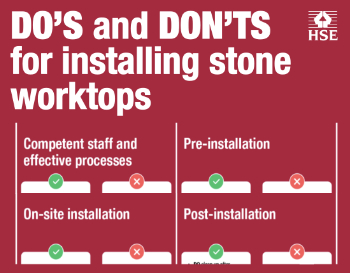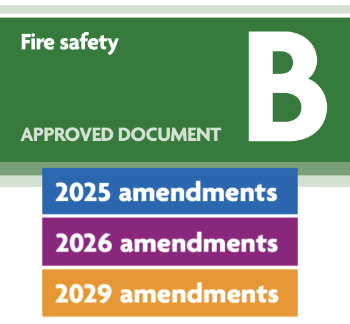HSE simplified advice for installers of stone worktops following company fine
Contents |
[edit] HSE guide of do’s and don'ts for installing stone worktops
Britain’s workplace safety regulator has published a helpful guide of do’s and don'ts for people installing stone worktops.
The Health and Safety Executive’s (HSE) guidance is designed to remind dutyholders and workers about the need to ensure that suitable procedures and controls are in place to help protect against exposure to stone dust and prevent workers breathing in respirable crystalline silica (RCS).
Stone workers are at risk of exposure to airborne particles of stone dust containing RCS when processing stone, including engineered stone, by cutting, chiselling and polishing. Over time, breathing in these silica particles can cause irreversible, life-changing and often fatal respiratory conditions such as silicosis, chronic obstructive pulmonary disease and lung cancer.
HSE’s guidance covers: Competent staff & effective processes, Pre-Installation, On-site Installation, and Post-installation.
[edit] Steps to minimise the risk of exposure
Here are just some of the important steps that can be taken to minimise the risk of exposure:
- Installers should understand the risk from processing stone and how to use suitable controls;
- Worktops should be pre-fabricated so further processing on site is avoided;
- Water suppression or on-tool extraction with shroud and dust collector attached to an M-class vacuum should be used to control any dust generated;
- Respiratory protective equipment with an assigned protection factor (APF) of at least 20 (e.g. FFP3 face mask) should be worn when processing the stone
- Cleaning should be by wet methods or dust class M vacuum to prevent creation of dust
A link to the guidance is available here –Silica in Stoneworking – Work Right to keep Britain safe.
[edit] Comments and COSHH
Mike Calcutt, Deputy Director at Health and Work, said: “HSE will continue to work with industry stakeholders to raise awareness of managing the risks from exposure to respirable crystalline silica. It’s important that businesses act now to ensure they comply with the law and protect their workers from serious lung diseases.
“Great Britain has a robust and well-established regulatory framework in place to protect workers from the health risks associated with exposure to hazardous substances. We want employers and workers to make sure they are aware of the risks associated with the activities they do, and that’s why we are sending this reminder.
“HSE’s inspectors have often found poor management of control measures including water suppression, dust extraction, equipment maintenance, cleaning and RPE provision. Employers should ensure suitable control measures are properly used and maintained.”
Employers have a legal duty to create suitable arrangements to manage health and safety and ensure they comply with the Control of Substances Hazardous to Health Regulations 2002 (COSHH) (as amended). Businesses should have in place effective control measures, including combinations of the enclosure and automation of processing equipment, use of water suppression and control of any mist generated and personal protective equipment such as RPE, to reduce workers’ exposure to the RCS.
[edit] Stone company fined after repeatedly failing to protect workers
A company that produces stone products and its director were fined a total of just under £20,000 after repeatedly failing to protect workers from exposure to Respirable Crystalline Silica (RCS).
The Health and Safety Executive (HSE) carried out several inspections at the company, which produces carved stone masonry products using limestone, sandstone, granite and marble, starting in May 2023. Photos taken at the scene by HSE show the extent of the dust.
Following the inspections, the company was served with seven improvement notices, which covered several failures including exposure to stone dust, control of legionella bacteria and inadequate welfare facilities. When HSE inspectors returned in September 2023, five of the improvement notices had still not been complied with – despite the company being given an extension to do so following another visit in August.
The company had shown reckless disregard of several health and safety issues including the assessment and control of respirable dust, and the company’s standard of health and safety management was far below what is required by health and safety law, leading to HSE’s proactive prosecution for failure to control the exposure of workers to RCS. The company ignored enforcement notices served against them by HSE
Stone workers are at risk of exposure to airborne particles of stone dust containing RCS when processing stone, by cutting, chiselling and polishing. Over time, breathing in these silica particles can cause irreversible, life-changing and often fatal respiratory conditions such as silicosis, chronic obstructive pulmonary disease and lung cancer. HSE provides a range of guidance for stone workers Stoneworkers: Health and safety topics. The company failed to protect its workers from exposure to RCA dust
After the hearing the HSE inspector said: “The company management responsible for health and safety were neither informed nor competent enough to carry out their role under the law. Over time, the basic measures to secure the health of all on site had not been taken, there had been no attempt to assess health risks and existing control measures had not been properly maintained. The company failed to take the initiative in health and safety matters and seek guidance, instruction and competent advice on implementation and communication of those measures necessary to control the risks at the site. The provision of suitable protection for worker’s health is a basic requirement that this company has failed to meet. HSE will not hesitate to take appropriate action against those that fail to comply with the requirements of enforcement notices.”
The company pleaded guilty to breaching section 21 of Health and Safety at Work Act 1974 by failing to comply with an Improvement Notice, breaching Regulation 7(1) of the Control of Substances Hazardous to Health Regulations 2002 by failing to adequately control employee exposure to a substance hazardous to health namely RCS and breaching Regulation 9(2)(a) the same Regulations by failing to have local exhaust ventilation subject to a thorough examination and test at least every 14 months. They were fined £18,000 and ordered to pay costs of £4,064.
The Director pleaded guilty to being a director of a company that had breached Regulation 7(1) of the Control of Substances Hazardous to Health Regulations 2002 by failing to adequately control employee exposure to a substance hazardous to health namely RCS and breaching Regulation 9(2)(a) of the same Regulations by failing to have local exhaust ventilation subject to a thorough examination and test at least every 14 months, those offences being committed with his consent, connivance or neglect. He was fined £1,062, and ordered to pay costs of £3,782.
This article was issued via the HSE press releases': 'Stone company fined after repeatedly failing to protect workers' and 'New simplified advice for installers of stone worktops' dated 6 and 7 January 2025, respectively.
[edit] Related articles on Designing Buildings
- CDM.
- Competent person.
- Construction dust.
- Construction health risks.
- Contaminated land.
- COSHH.
- Deleterious materials.
- Design risk management.
- Designing to reduce the chemical, biological and radiological vulnerability of new buildings (IP 7/15).
- Disposal.
- Hazardous substances.
- Health and safety file.
- Health and safety.
- Health and Safety Executive.
- Injuries on construction sites.
- Mastic asphalt flooring.
- Method statement.
- Occupational health.
- Personal protective equipment.
- Planning (Hazardous Substances) Act 1990.
- Pollution.
- Pre-construction information.
- Principal contractor.
- Registration, evaluation, authorisation and restriction of chemicals REACH.
- Reporting accidents and injuries on construction sites.
- Risk assessment.
- Site waste management plan.
- Volatile organic compounds.
- Workplace exposure limits.
- Work at height regulations.
[edit] External links and further Information
Sign up for regular updates from HSE on silica here.
ST0: Advice for Managers (PDF)
INDG463: Control of exposure to silica dust – A guide for employeesHSG201: Controlling exposure to stone dust
Featured articles and news
HSE simplified advice for installers of stone worktops
After company fined for repeatedly failing to protect workers.
Co-located with 10th year of UK Construction Week.
How orchards can influence planning and development.
Time for knapping, no time for napping
Decorative split stone square patterns in facades.
A practical guide to the use of flint in design and architecture.
Designing for neurodiversity: driving change for the better
Accessible inclusive design translated into reality.
RIBA detailed response to Grenfell Inquiry Phase 2 report
Briefing notes following its initial 4 September response.
Approved Document B: Fire Safety from March
Current and future changes with historical documentation.
A New Year, a new look for BSRIA
As phase 1 of the BSRIA Living Laboratory is completed.
A must-attend event for the architecture industry.
Caroline Gumble to step down as CIOB CEO in 2025
After transformative tenure take on a leadership role within the engineering sector.
RIDDOR and the provisional statistics for 2023 / 2024
Work related deaths; over 50 percent from construction and 50 percent recorded as fall from height.
Solar PV company fined for health and safety failure
Work at height not properly planned and failure to take suitable steps to prevent a fall.
The term value when assessing the viability of developments
Consultation on the compulsory purchase process, compensation reforms and potential removal of hope value.
Trees are part of the history of how places have developed.
























